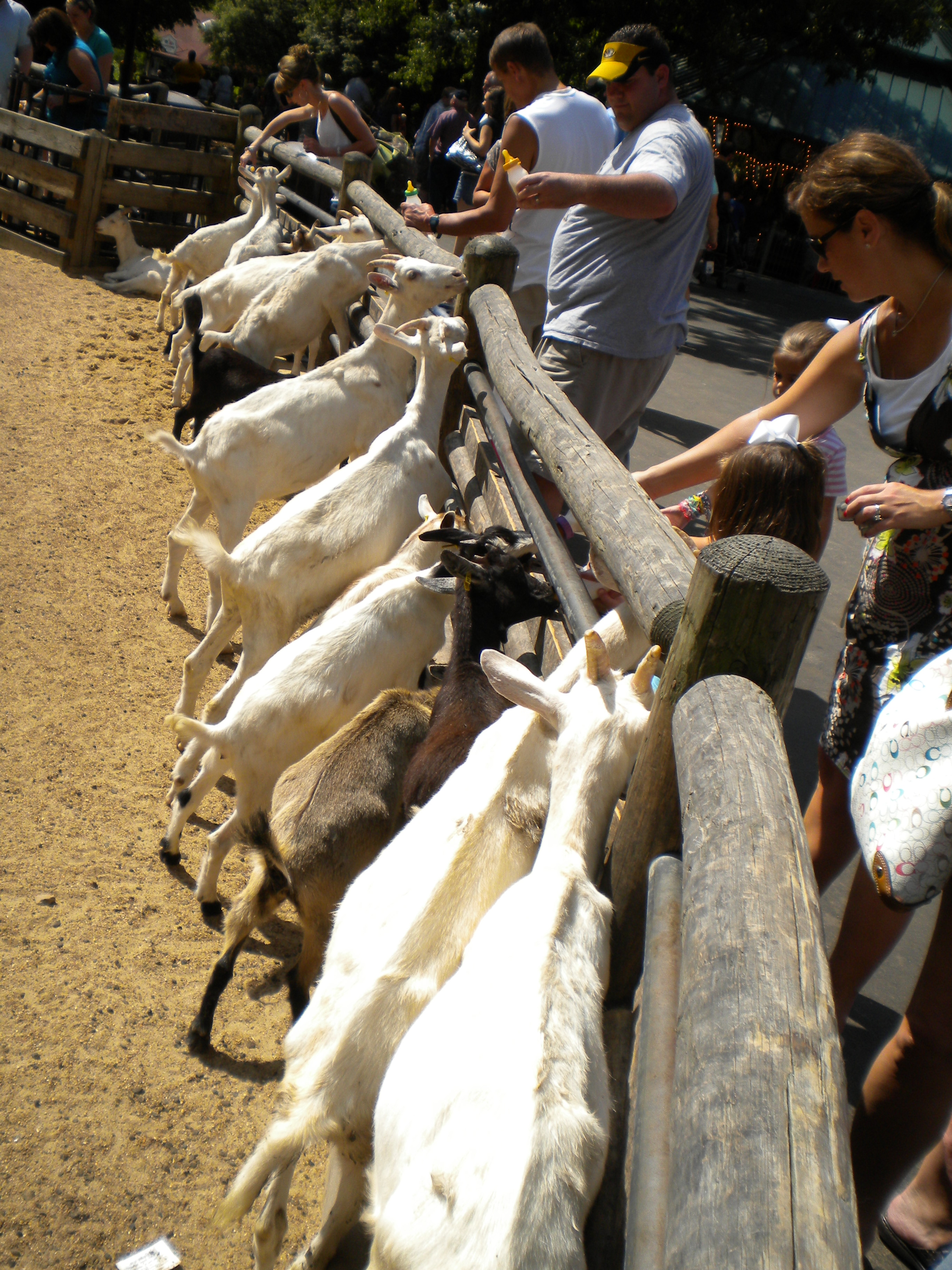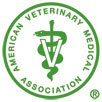 I find it physically impossible for me to get enough animal interaction. I suppose that means I must’ve chosen the right profession: Veterinary Medicine. I’m a frequent patron of Sunset Zoo here in Manhattan, Kansas, but during my last visit I was sad to learn that the petting zoo area was sectioned off from the public. Zoo patrons are still able to go up to the fence to pet the goats, but they can no longer walk amongst them in their enclosure. I have no idea if this change had to do with any of the recent petting zoo outbreaks, but I suppose it’s a step in the right direction for public health.
I find it physically impossible for me to get enough animal interaction. I suppose that means I must’ve chosen the right profession: Veterinary Medicine. I’m a frequent patron of Sunset Zoo here in Manhattan, Kansas, but during my last visit I was sad to learn that the petting zoo area was sectioned off from the public. Zoo patrons are still able to go up to the fence to pet the goats, but they can no longer walk amongst them in their enclosure. I have no idea if this change had to do with any of the recent petting zoo outbreaks, but I suppose it’s a step in the right direction for public health.

The large number of sick kids resulted from a combination of poor food safety information and slow reporting by health officials. There are quite a lot of petting zoos that do things wrong, such as not providing access to handwashing stations after animal interaction. This past weekend I visited a petting zoo in St. Louis, and I was pleased to see some food safety signs posted outside the gate of the animal area and also by the handwashing station right next to the animals.
The petting zoo I visited was inside of
http://www.grantsfarm.com, a historic plot of land within St. Louis formerly owned by Gen. Grant and currently operated by the Busch family. The petting zoo was entirely made up of goats, and for a few dollars patrons could purchase a baby bottle full of milk to feed to the goats. The handwashing stations with soap and water right next to the exits satisfied my public health concerns. However, I would’ve been happier with paper towels for drying rather than the hand dryers that were available.
.jpg)
I was also happy about the signs posted around the petting zoo that read,
In accordance with the U.S. Center for Disease Control and Prevention, we provide hand washing stations, antibacterial soap, warm water, and air hand dryers for visitors to our animal interaction areas. Additionally, petting brushes are available to reduce hand contact with the animals.
Posted below was,
Pregnant women, senior citizens and immunocompromised persons are at higher risk of serious infections. When contacting animals, Grant’s Farm suggests heightened precautions, and children under 5 years be closely supervised.
Of course these signs were nice to have around, but it doesn’t mean anything if parents don’t read them. Unfortunately I saw quite a few kids with their hands in their mouths inside the petting enclosure. I think Grant’s Farm did a good job of informing the public of the risks while still encouraging people to pet the animals. The petting brushes are a germ-a-phobe’s dream, though I didn’t use one.
All in all, the kids had a blast and the goats were fed. And now I have 52 pictures of goats on my camera.
I find it physically impossible for me to get enough animal interaction. I suppose that means I must’ve chosen the right profession: Veterinary Medicine. I’m a frequent patron of Sunset Zoo here in Manhattan, Kansas, but during my last visit I was sad to learn that the petting zoo area was sectioned off from the public. Zoo patrons are still able to go up to the fence to pet the goats, but they can no longer walk amongst them in their enclosure. I have no idea if this change had to do with any of the recent petting zoo outbreaks, but I suppose it’s a step in the right direction for public health.
.jpg) I was also happy about the signs posted around the petting zoo that read,
I was also happy about the signs posted around the petting zoo that read,
.jpg) Drinking on the job is generally not allowed, unless you work at a brewery.
Drinking on the job is generally not allowed, unless you work at a brewery..jpg) The world’s fourth largest brewer, Carlsberg had been considering the restrictions for years. The new policy resulted in a strike of around 800 workers on Wednesday and continued into Thursday as around 250 walked off their jobs Thursday. On Friday afternoon, Michael Christiansen (truck driver turned union representative) sent his men back to work temporarily after management agreed to renegotiate workers’ right to free beer in coming weeks.
The world’s fourth largest brewer, Carlsberg had been considering the restrictions for years. The new policy resulted in a strike of around 800 workers on Wednesday and continued into Thursday as around 250 walked off their jobs Thursday. On Friday afternoon, Michael Christiansen (truck driver turned union representative) sent his men back to work temporarily after management agreed to renegotiate workers’ right to free beer in coming weeks. Dr. Dan Upson presented
Dr. Dan Upson presented  These topics highlighted the current state of the agriculture industry, which has come under attack in recent years for utilizing technology to improve production methods.
These topics highlighted the current state of the agriculture industry, which has come under attack in recent years for utilizing technology to improve production methods. The American Veterinary Medical Association (AVMA) reports
The American Veterinary Medical Association (AVMA) reports My favorite character from the Ghostbusters series is Slimer, mainly because he always seems to get away with causing chaos around him. As a kid, I didn’t think too much about his puke-green color or possible germs that he might be carrying. However, after reading
My favorite character from the Ghostbusters series is Slimer, mainly because he always seems to get away with causing chaos around him. As a kid, I didn’t think too much about his puke-green color or possible germs that he might be carrying. However, after reading  Vestby studied the effect of nine most frequently used disinfectants and found that their efficiency is substantially reduced of the Salmonella has managed to form a biofilm. The effect of the majority of the disinfectants was then no longer satisfactory, but a product containing 70% ethanol was the most efficient, followed by one called Virkon S. These results could improve the efficiency of the cleaning procedures used by processing plants in the animal feed industry, and also in the human food industry.
Vestby studied the effect of nine most frequently used disinfectants and found that their efficiency is substantially reduced of the Salmonella has managed to form a biofilm. The effect of the majority of the disinfectants was then no longer satisfactory, but a product containing 70% ethanol was the most efficient, followed by one called Virkon S. These results could improve the efficiency of the cleaning procedures used by processing plants in the animal feed industry, and also in the human food industry. 
.jpeg) chance that you’ve come across one. A wal-creature is anyone shopping at Wal-Mart wearing outlandish or ridiculous clothing, whether it be too tight or blindingly bright. A wal-creature could be Mimi from Drew Carey. Wal-creatures may be encountered in real life, but more often are photographed and put up on one of my favorite sites:
chance that you’ve come across one. A wal-creature is anyone shopping at Wal-Mart wearing outlandish or ridiculous clothing, whether it be too tight or blindingly bright. A wal-creature could be Mimi from Drew Carey. Wal-creatures may be encountered in real life, but more often are photographed and put up on one of my favorite sites:  I’m pretty surprised that some of these people leave their house dressed as they are. Secondly, I can’t believe how many of these people have been photographed in the store with animals. There aren’t too many Wal-Marts around without a food section, so there’s a very good chance that these animals have accompanied their owners on that side of the store. Peopleofwalmart.com includes photos of wal-creatures with
I’m pretty surprised that some of these people leave their house dressed as they are. Secondly, I can’t believe how many of these people have been photographed in the store with animals. There aren’t too many Wal-Marts around without a food section, so there’s a very good chance that these animals have accompanied their owners on that side of the store. Peopleofwalmart.com includes photos of wal-creatures with  In my opinion, the photo with the macaw is the most disturbing. The caption says it best: “Oh no Ms., it’s cool, I love stepping in parrot sh*t whenever I’m buying celery. Nothing says sanitary like a parrot in the produce section…” I cannot believe this lady got away with bringing a giant Salmonella factory into the produce section of a grocery store. I’m a big proponent of service dogs – dogs only. This bird’s rectum is pointed precariously close to the cases of strawberries. Unfortunately the manager at the store couldn’t have done anything about it (whether he was aware of the bird in the store or not). Laws are in place to protect disabled people with service animals from being asked to leave stores. Managers are not even allowed to ask what their disability is (which isn’t overly apparent in this situation) and disabled patrons are not required to show documentation for their service animals. I wish this could be regulated somehow because I have suspicions that the bird isn’t a real service animal, instead it’s just a pet.
In my opinion, the photo with the macaw is the most disturbing. The caption says it best: “Oh no Ms., it’s cool, I love stepping in parrot sh*t whenever I’m buying celery. Nothing says sanitary like a parrot in the produce section…” I cannot believe this lady got away with bringing a giant Salmonella factory into the produce section of a grocery store. I’m a big proponent of service dogs – dogs only. This bird’s rectum is pointed precariously close to the cases of strawberries. Unfortunately the manager at the store couldn’t have done anything about it (whether he was aware of the bird in the store or not). Laws are in place to protect disabled people with service animals from being asked to leave stores. Managers are not even allowed to ask what their disability is (which isn’t overly apparent in this situation) and disabled patrons are not required to show documentation for their service animals. I wish this could be regulated somehow because I have suspicions that the bird isn’t a real service animal, instead it’s just a pet..png)
 This Christmas, consider giving a Barbie to a little girl or some sort of Pokémon a little boy. I’m not really a fan of either (anymore), but they probably won’t leave you infected with a zoonotic bacterium. One of the veterinary students at K-State sent out an email earlier this week telling us about her neighbors that rescued some turtle eggs from a construction site and were successful with having them hatch. It was also included in the email that they were red-eared sliders between 2.5-3 inches, and “just think a perfect free gift for a kid you know.”
This Christmas, consider giving a Barbie to a little girl or some sort of Pokémon a little boy. I’m not really a fan of either (anymore), but they probably won’t leave you infected with a zoonotic bacterium. One of the veterinary students at K-State sent out an email earlier this week telling us about her neighbors that rescued some turtle eggs from a construction site and were successful with having them hatch. It was also included in the email that they were red-eared sliders between 2.5-3 inches, and “just think a perfect free gift for a kid you know.” I’ve contacted the vet student who sent me the original email, but she says she has spoken to one of the veterinarians associated with Kansas State who said that unless an individual has 3 or greater turtles there wasn’t a need for a license to give them away. I chatted with the vet myself, and he says that two limiting factors of owning a turtle are the long life span and meeting the complex dietary needs. We both agreed that turtles aren’t the best pet for a young child and that Salmonellosis was the
I’ve contacted the vet student who sent me the original email, but she says she has spoken to one of the veterinarians associated with Kansas State who said that unless an individual has 3 or greater turtles there wasn’t a need for a license to give them away. I chatted with the vet myself, and he says that two limiting factors of owning a turtle are the long life span and meeting the complex dietary needs. We both agreed that turtles aren’t the best pet for a young child and that Salmonellosis was the .jpeg) The New York Times reports
The New York Times reports.jpeg) Currently an estimated 2 million to 2.5 million boars roam the forests, suburbs and maize fields of Germany. No national program seems to be set up to eradicate this problem, but local hunters do their best by enjoying a
Currently an estimated 2 million to 2.5 million boars roam the forests, suburbs and maize fields of Germany. No national program seems to be set up to eradicate this problem, but local hunters do their best by enjoying a  I’m H1N1-ready. The vaccine that I received this evening will start providing immunity in a few weeks. I received one of a
I’m H1N1-ready. The vaccine that I received this evening will start providing immunity in a few weeks. I received one of a .jpg)